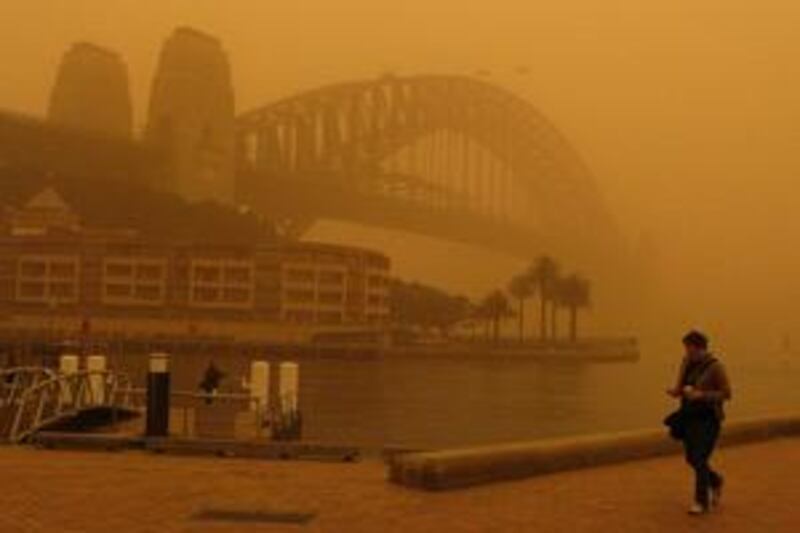SYDNEY // Australian scientists have reported that the massive dust cloud that swept across eastern parts of the continent last month has highlighted an unusual but effective way to tackle climate change.
The freak event dumped huge amounts of soil and sediment into the ocean between Australia and New Zealand, where the nutrients dissolved and were seized upon by carbon-ingesting plankton, tiny algae that could prove to be a potent weapon in man's fight against warming temperatures. "Our calculations suggest that the Tasman Sea absorbed about eight million tonnes of carbon dioxide due to this dust storm," said Ian Jones, a professor of engineering at the University of Sydney, who explained that this amount of carbon was roughly the equivalent of a year's emissions from a coal-fired power station.
"We measured the phytoplankton, the vegetable matter that actually takes the carbon dioxide out of the water, each day before and after the storm. Immediately after there was no change but after five days the phytoplankton had tripled in mass and they'd taken that carbon dioxide out of the air just like trees take carbon dioxide out of the air." The gases remain trapped inside the algae and when these minute organisms die they drift into deep water, storing the carbon far from the atmosphere indefinitely. Researchers have estimated that this process has over time locked away 40,000 billion tonnes of carbon in the world's oceans.
Prof Jones and his team have been investigating methods to artificially stimulate the carbon-soaking qualities of the plankton by nourishing the marine environment in much the same way that farmers fertilise the land. "The technique we are practising is taking urea, the powdered form of nitrogen, on a ship and broadcasting it over the sea. This floats away from the vessel and after a few days the phytoplankton will have made an enriched patch. We expect the fish will congregate there and fatten up and so one of the benefits as well as helping the climate, it actually helps the food chain in the ocean," said Prof Jones. He estimated that a fertilised tract of ocean 20 sq km in size could soak up 10 million tonnes of carbon dioxide a year while also producing one million tonnes of fish.
Experiments have been conducted in waters off the Philippines, Morocco and China, and the early results have been encouraging. "If you had a number of these patches, which aren't very large, you could make a significant dent in the protein supply for the future and in the amount of carbon dioxide left in the atmosphere," Prof Jones said. The dust storm sent a choking haze across heavily populated areas and was propelled by strong winds that whipped up the most fertile soil from drought-hit areas, causing millions of dollars in damage to agriculture.
"That event we've nicknamed 'Red Dawn'," said Craig Strong, from the DustWatch programme at Queensland's Griffith University. The programme was set up four years ago to examine the severity of wind erosion across Australia. "I think it is really hard for people to grasp the extent of this. Some of these areas have lost five to 10 millimetres of topsoil, and that is significant. Essentially what [the dust storms] are doing is removing the highly productive component of the soil, your nutrients, your carbon and your organic matter. In effect what happens, [the dust storms] start to create a more sandy landscape in these arid areas."
While the inland agricultural areas are losing their best soil to dust storms, the areas where the soil is being deposited - mostly along the coast, including in the sea - are benefiting. "You have this negative effect close to source and then you have this gain further downwind," said Dr Strong. He warned that dust storms were likely to become more frequent as Australia moved into the hot summer months, when wind erosion was usually at its worst. This grim prediction will cause concern to people with respiratory ailments such as asthma, which affects about 10 per cent of Australians.
Greg Smith, the chief executive officer of the Asthma Foundation New South Wales, said the recent dusty haze "constituted a perfect storm" for those suffering from the debilitating condition. "It combined the incredible level of dust in this red sky with a sudden drop in temperature, which is really bad for asthmatics, and high winds and pollen. It was really bad news," said Mr Smith. "It was a pretty stunning event, then a few days later it happened again. We had another burst of the dust and then, of course, it links into the whole question about what's happening to the environment and people begin to think is it going to be like this on a more regular basis and whether nature is seeming to be more aggressive or violent," he added.
@Email:foreign.desk@thenational.ae






